Numerical Study on Flow, Temperature, and Concentration Distribution Features of Combined Gas and Bottom-Electromagnetic Stirring in a Ladle
Abstract
:1. Introduction
2. Model Descriptions
2.1. Basic Assumptions
- (1)
- The molten steel is an incompressible continuous fluid, and the bubbles are a discrete phase fluid with a constant diameter of 4 mm, the average bubble diameter was evaluated from empirical equation proposed by Davidson and Schuler [19];
- (2)
- The break-up and coalescence of gas bubbles are neglected;
- (3)
- The ladle is filled with molten steel and the effect of the slag layer on the fluid flow is ignored;
- (4)
- The buoyant force and electromagnetic force (EMF) are mainly responsible for the fluid flow and the movement of bubbles;
- (5)
- The effect of temperature on the physical properties is ignored and the parameter of materials is regarded as a constant;
- (6)
- The displacement current is negligible.
2.2. Governing Equations
2.2.1. Eulerian-Eulerian Model
2.2.2. Turbulent Model
2.2.3. Electromagnetism Model
2.2.4. Energy Transfer Model
2.2.5. Discrete Phase Model
2.2.6. Species Transport Model
3. Geometrical Model and Computational Conditions
3.1. Geometrical Model and Verification of Grid-Independence
3.2. Computational Method and Boundary Conditions
4. Results and Discussion
4.1. Analysis of Electromagnetic Force
4.2. Analysis of Flow Field
4.3. Analysis of Temperature Field
4.4. Analysis of Concentration Field
5. Conclusions
- (1)
- The electromagnetic force consists of a horizontal component spinning clockwise and vertical component upwards. Current intensity plays a critical role on the magnitude of electromagnetic force.
- (2)
- After the combined method is imposed, the gas-liquid plume region is deflected and expanded, and the EMF-driven rotational flow has positive influence of improving the dispersion of bubbles, which contribute to prolonging the residence time of bubbles and weaken the impingement effect of bubbles on the slag layer.
- (3)
- When the combined method is adopted, the temperature stratification tends to alleviate due to the effect of heat compensation and the improved flow. The temperature stratification tends to disappear when the current reaches 1200 A.
- (4)
- The improved flow has a positive influence on decreasing concentration stratification and shortening the mixing time when the combined method is used. However, the alloy depositing site needs to be optimized according to the whole circulatory flow and the region of bubbles to escape.
Acknowledgments
Author Contributions
Conflicts of Interest
Nomenclature
| A | Magnetic vector potential (Wb·m) | Re | Real part of a complex quantity |
| B | Magnetic flux density (T) | Reb | Bubble Reynolds number (dimensionless) |
| C | Mass fraction of the species (dimensionless) | Rem | Magnetic Reynolds number (dimensionless) |
| CD | Drag force coefficient (dimensionless) | SCt | Turbulent Schmidt number (dimensionless) |
| CL | Lift force coefficient (dimensionless) | t | Time (s) |
| cp | Specific heat capacity at constant pressure (J·kg−1·K−1)) | T | Temperature (K) |
| CTD | Turbulent dispersion coefficient (dimensionless) | ub | Velocity of argon bubble (m·s−1) |
| CVM | Virtual mass force coefficient (dimensionless) | ug | Velocity of the gas phase (m·s−1) |
| Cμ,T | Model constant (dimensionless) | ul | Velocity of the liquid phase (m·s−1) |
| Cε1 | Model constant (dimensionless) | xb | Displacement of argon bubble (m) |
| Cε2 | Model constant (dimensionless) | ||
| D0 | Diffusion coefficient (m2·s−1) | Greek symbols | |
| db | Diameter of argon bubble (m) | α | Volume fraction (dimensionless) |
| E | Electric field intensity (V·m−1) | ε | Turbulent dissipation rate (m2·s−3) |
| FB | Buoyancy force (N·m−3) | λ | Thermal conductivity (W·m−1·K−1) |
| FD | Drag force (N·m−3) | η | Magnetic permeability (H·m−1) |
| FEM | Electromagnetic repulsive force (N·m−3) | μeff | Effective viscosity of the fluid (kg·m−1·s−1) |
| FL | Lift force (N·m−3) | μT,l | Turbulent eddy viscosity (kg·m−1·s−1) |
| Fmag | Lorentz force (N·m−3) | μl | Dynamic viscosity of liquid phase (kg·m−1·s−1) |
| FP | Pressure gradient force (N·m−3) | ρg | Density of the argon gas (kg·m−3) |
| FTD | Turbulent dispersion force (N·m−3) | ρl | Density of the molten steel (kg·m−3) |
| FVM | Virtual mass force (N·m−3) | σ | Electrical conductivity (S·m−1) |
| FWL | Wall lubrication force (N·m−3) | σk | Model constant (dimensionless) |
| g | Gravitational acceleration (m·s−2) | σε | Model constant (dimensionless) |
| H | Magnetic intensity (A·m−1) | σT,l | Turbulent Schmidt number (dimensionless) |
| J | Current density (A·m−2) | φ | Electric scalar potential (V) |
| Je | Induced current density (A·m−2) | ω | Angular frequency (rad·s−1) |
| Js | Source current density (A·m−2) | Subscript | |
| k | Turbulent kinetic energy (m2·s−2) | l | Liquid phase |
| p | Pressure (Pa) | g | Gas phase |
| Qv | Joule heat (W·m−3) | b | Argon gas bubble |
References
- Wu, L.; Valentin, P.; Sichen, D. Study of Open Eye Formation in an Argon Stirred Ladle. Steel Res. Int. 2010, 81, 508–515. [Google Scholar] [CrossRef]
- Alexis, J.; Jonsson, P.; Jonsson, L. Heating and electromagnetic stirring in a ladle furnace—A simulation model. ISIJ Int. 2000, 40, 1098–1104. [Google Scholar] [CrossRef]
- Dayal, P.; Beskow, K.; Bjorkvall, J.; Sichen, D. Study of stag/metal interface in ladle treatment. Ironmak. Steelmak. 2006, 33, 454–464. [Google Scholar] [CrossRef]
- Huang, A.; Harmuth, H.; Doletschek, M.; Vollmann, S.; Feng, X. Toward CFD Modeling of Slag Entrainment in Gas Stirred Ladles. Steel Res. Int. 2015, 86, 1447–1454. [Google Scholar] [CrossRef]
- Inomoto, T.; Ogawa, Y.; Toh, T. Promotion of desulphurization in ladle through slag emulsification by stirring with stationary AC electromagnetic field. ISIJ Int. 2003, 43, 828–835. [Google Scholar] [CrossRef]
- Xu, Y.; Ersson, M.; Jonsson, P.G. A Mathematical Modeling Study of Bubble Formations in a Molten Steel Bath. Metall. Mater. Trans. B 2015, 46, 2628–2638. [Google Scholar] [CrossRef]
- Delobelle, P.; Oytana, C. Study of slag/metal interface in ladle treatment. Ironmak. Steelmak. 2013, 33, 454–464. [Google Scholar]
- Li, B.; Yin, H.; Zhou, C.Q.; Tsukihashi, F. Modeling of Three-phase Flows and Behavior of Slag/Steel Interface in an Argon Gas Stirred Ladle. Trans. Iron Steel Inst. Jpn. 2008, 48, 1704–1711. [Google Scholar] [CrossRef]
- Thunman, M.; Eckert, S.; Hennig, O.; Björkvall, J.; Du, S. Study on the Formation of Open-Eye and Slag Entrainment in Gas Stirred Ladle. Steel Res. Int. 2007, 78, 849–856. [Google Scholar] [CrossRef]
- Ramírez-Argáez, M.A. Numerical Simulation of Fluid Flow and Mixing in Gas-Stirred Ladles. Mater. Manuf. Process. 2007, 23, 59–68. [Google Scholar] [CrossRef]
- Warzecha, W.; Jowsa, J.; Merder, T. Gas Mixing And Chemical Homogenization of Steel In 100 T Ladle Furnace. Metalurgija 2007, 46, 227–232. [Google Scholar]
- Llanos, C.A.; Saul, G.H.; Angel, R.B.J.; Barreto, J.D.J.; Gildardo, S.D. Multiphase Modeling of the Fluidynamics of Bottom Argon Bubbling during Ladle Operations. ISIJ Int. 2010, 50, 396–402. [Google Scholar] [CrossRef]
- Geng, D.Q.; Lei, H.; He, J.C. Numerical Simulation for Collision and Growth of Inclusions in Ladles Stirred with Different Porous Plug Configurations. ISIJ Int. 2010, 50, 1597–1605. [Google Scholar] [CrossRef]
- Joo, S.; Guthrie, R.I.L. Modeling flows and mixing in steelmaking ladles designed for single- and dual-plug bubbling operations. Metall. Trans. B 1992, 23, 765–778. [Google Scholar] [CrossRef]
- Mietz, J.; Oeters, F. Model experiments on mixing phenomena in gas-stirred melts. Steel Res. 1988, 59, 52–59. [Google Scholar] [CrossRef]
- Tang, H.; Guo, X.; Wu, G.; Wang, Y. Effect of Gas Blown Modes on Mixing Phenomena in a Bottom Stirring Ladle with Dual Plugs. ISIJ Int. 2016, 12, 2161–2170. [Google Scholar]
- Chung, S.I.; Shin, Y.H.; Yoon, J.K. Flow Characteristics by Induction and Gas Stirring in ASEA-SKF Ladle. ISIJ Int. 1992, 32, 1287–1296. [Google Scholar] [CrossRef]
- Sand, U.; Yang, H.L.; Eriksson, J.E.; Fdhila, R.B. Numerical and Experimental Study on Fluid Dynamic Features of Combined Gas and Electromagnetic Stirring in Ladle Furnace. Steel Res. Int. 2009, 80, 441–449. [Google Scholar]
- Liu, H.; Qi, Z.; Xu, M. Numerical Simulation of Fluid Flow and Interfacial Behavior in Three-phase Argon-Stirred Ladles with One Plug and Dual Plugs. Steel Res. Int. 2011, 82, 440–458. [Google Scholar] [CrossRef]
- Wang, Q.; Yao, W. Computation and validation of the interphase force models for bubbly flow. Int. J. Heat Mass Transf. 2016, 98, 799–813. [Google Scholar] [CrossRef]
- Drew, D.A.; Lahey, R.T. The virtual mass and lift force on a sphere in rotating and straining inviscid flow. Int. J. Multiph. Flow 1987, 13, 113–121. [Google Scholar] [CrossRef]
- Burns, A.D.; Frank, T.; Hamill, I.; Shi, J.M. The Favre averaged drag model for turbulent dispersion in Eulerian multi-phase flows. In Proceedings of the Fifth International Conference on Multiphase Flow, Yokohama, Japan, 30 May–4 June 2004; pp. 391–392. [Google Scholar]
- Launder, B.E.; Spalding, D.B. The numerical computation of turbulent flows. Comput. Methods Appl. Mech. Eng. 1974, 3, 269–289. [Google Scholar] [CrossRef]
- Lou, W.; Zhu, M. Numerical Simulation of Gas and Liquid Two-Phase Flow in Gas-Stirred Systems Based on Euler–Euler Approach. Metall. Mater. Trans. B 2013, 44, 1251–1263. [Google Scholar] [CrossRef]
- Moreau, R. Magnetohydrodynamics; Kluwer Academic Pbulishers: Dordrecht, The Netherlands, 1990; p. 37. [Google Scholar]
- Jiang, D.; Zhu, M. Flow and Solidification in Billet Continuous Casting Machine with Dual Electromagnetic Stirrings of Mold and the Final Solidification. Steel Res. Int. 2015, 86, 993–1003. [Google Scholar] [CrossRef]
- Sivak, B.A.; Grachev, V.G.; Parshin, V.M.; Chertov, A.D.; Zarubin, S.V.; Fisenko, V.G.; Solov’Ev, A.A. Magnetohydrodynamic processes in the electromagnetic mixing of liquid phase in the ingot on continuous bar- and bloom-casting machines. Steel Transl. 2009, 39, 774–782. [Google Scholar] [CrossRef]
- Leenov, D.; Kolin, A. Theory of Electromagnetophoresis. I. Magnetohydrodynamic Forces Experienced by Spherical and Symmetrically Oriented Cylindrical Particles. J. Chem. Phys. 1954, 22, 683–688. [Google Scholar] [CrossRef]
- Ni, S.; Wang, H.; Zhang, J.; Lin, L.; Chu, S. A Novel Criterion of Mixing Time in Gas-Stirred Ladle Systems. Acta Metall. Sin. 2014, 27, 1008–1011. [Google Scholar] [CrossRef]
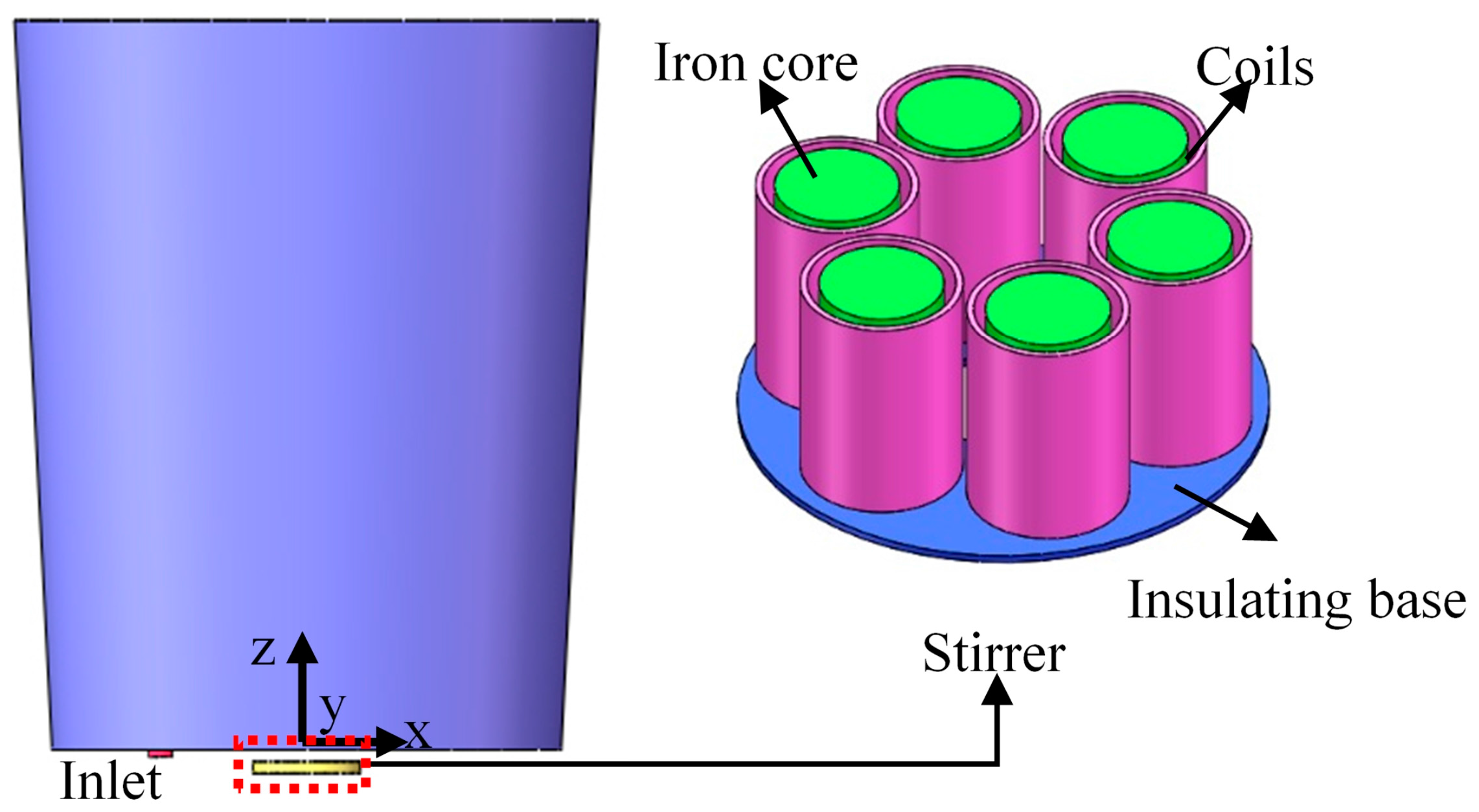
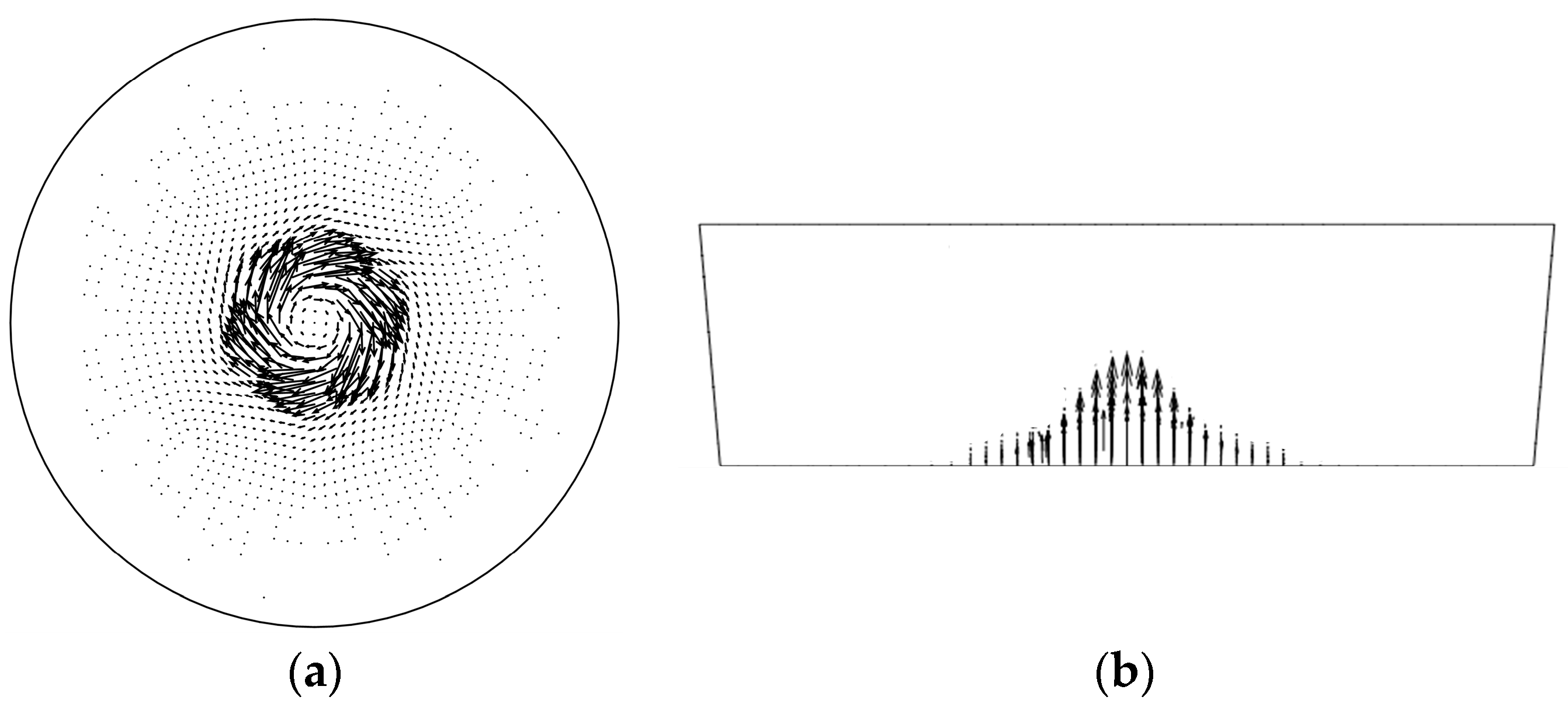
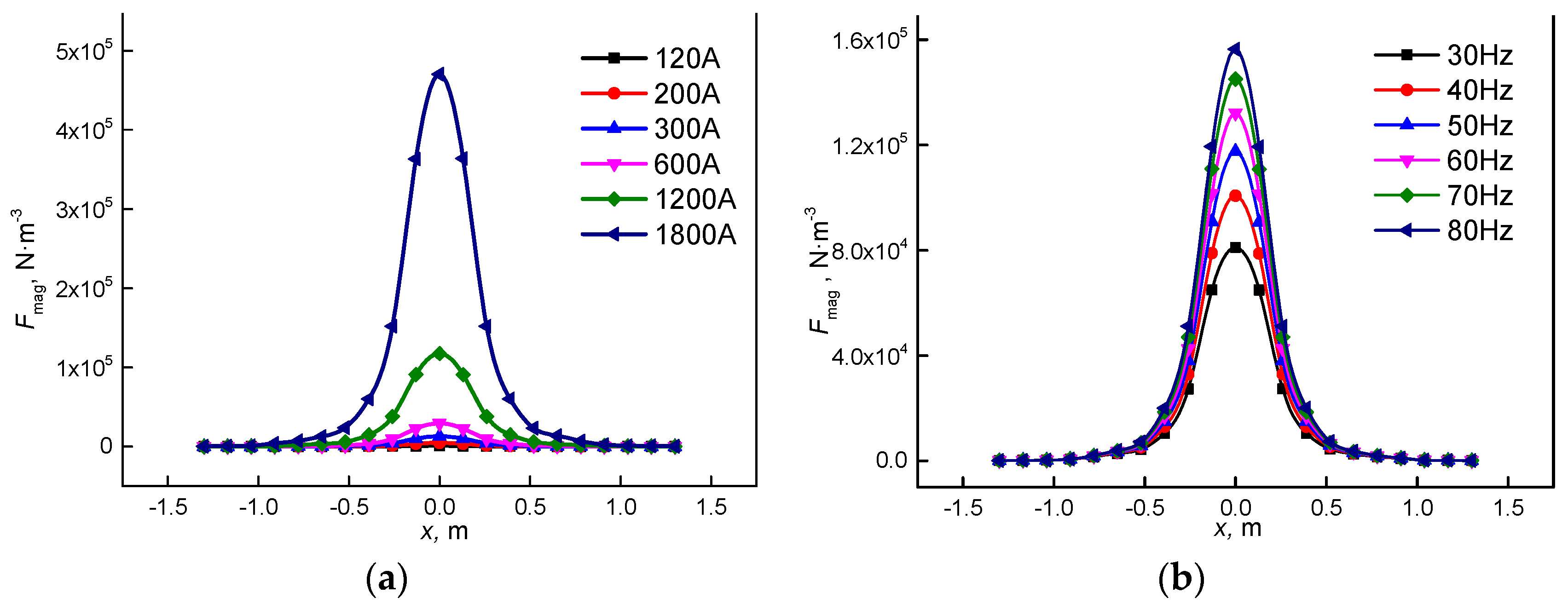
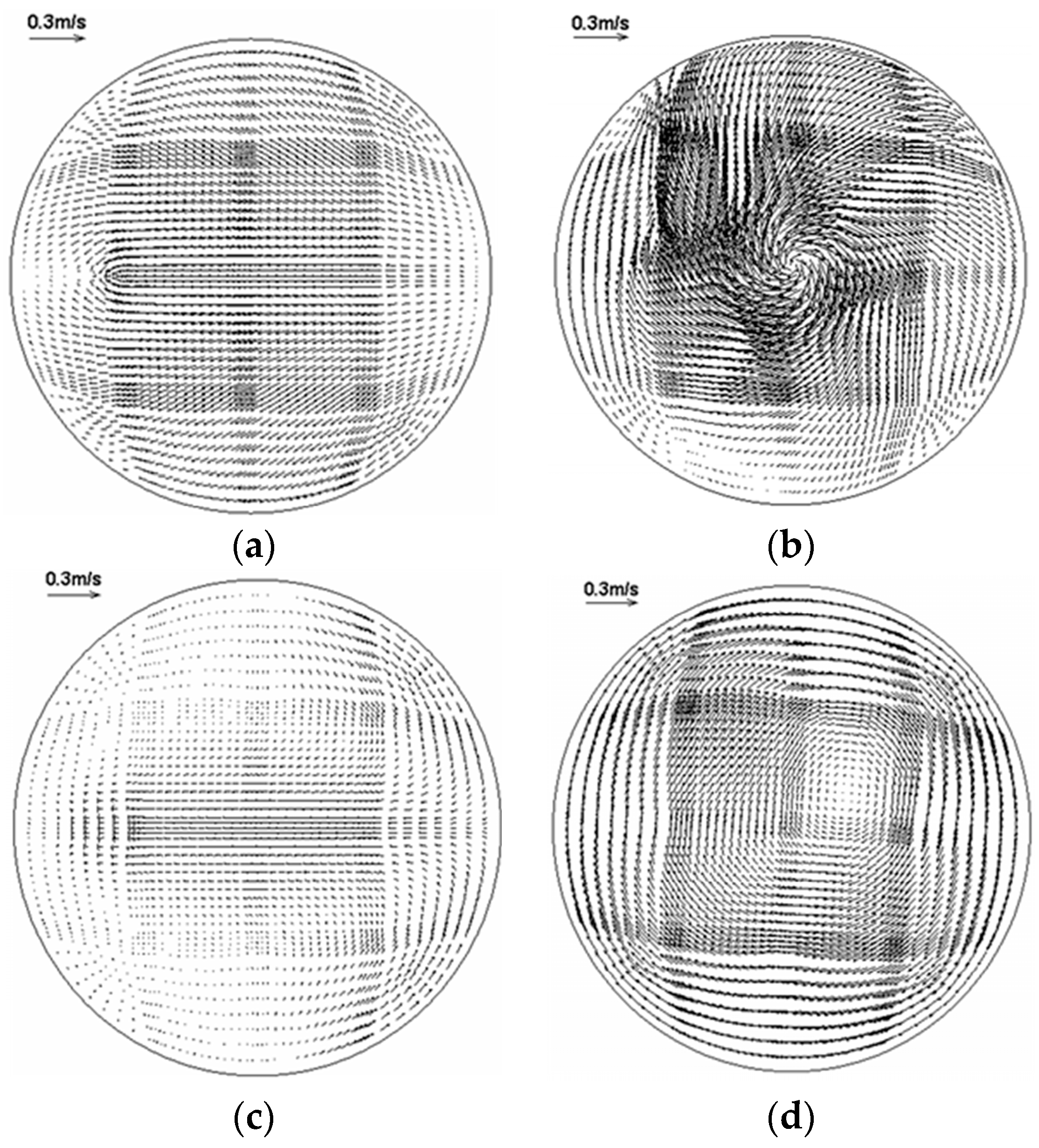

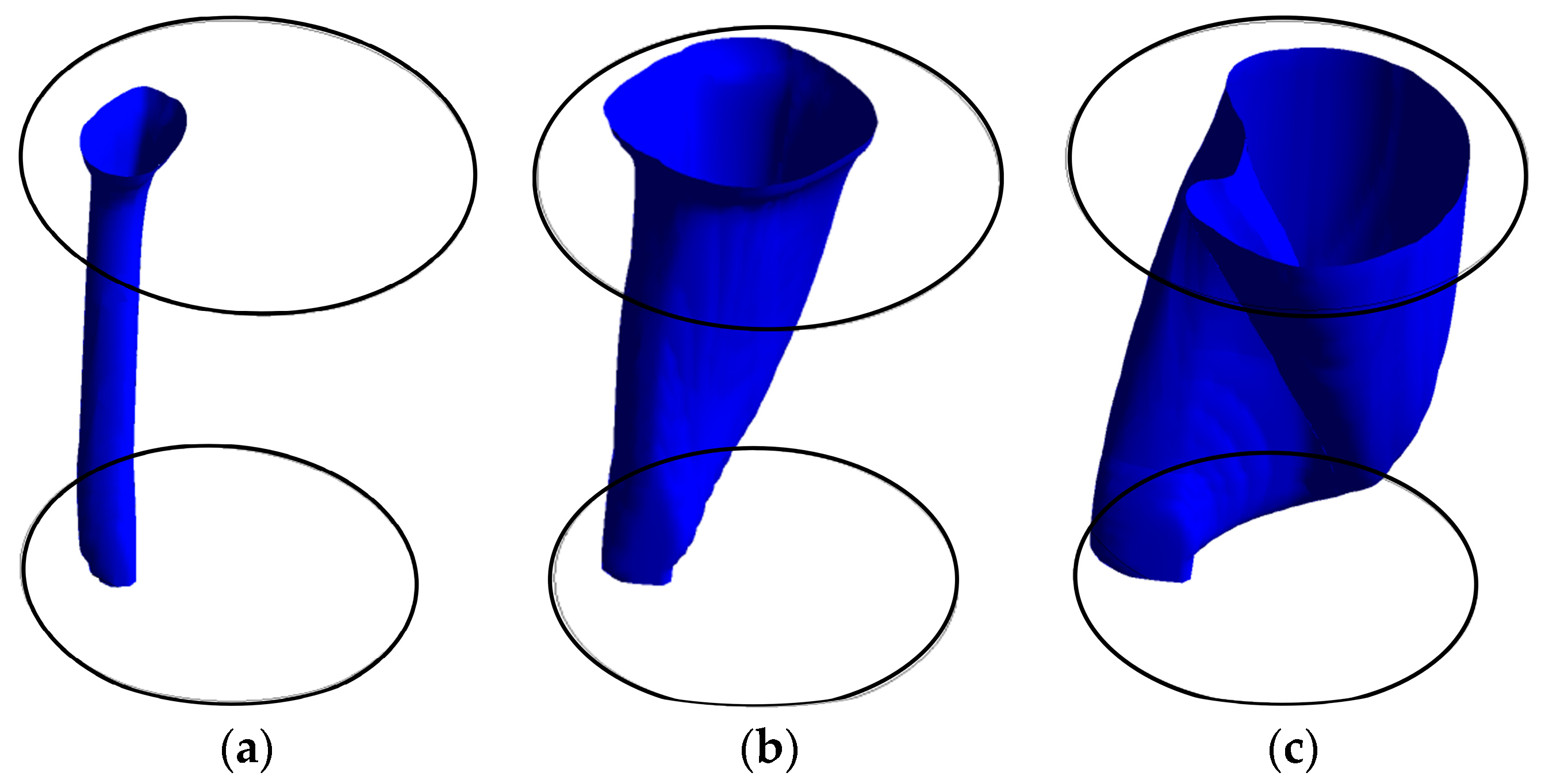

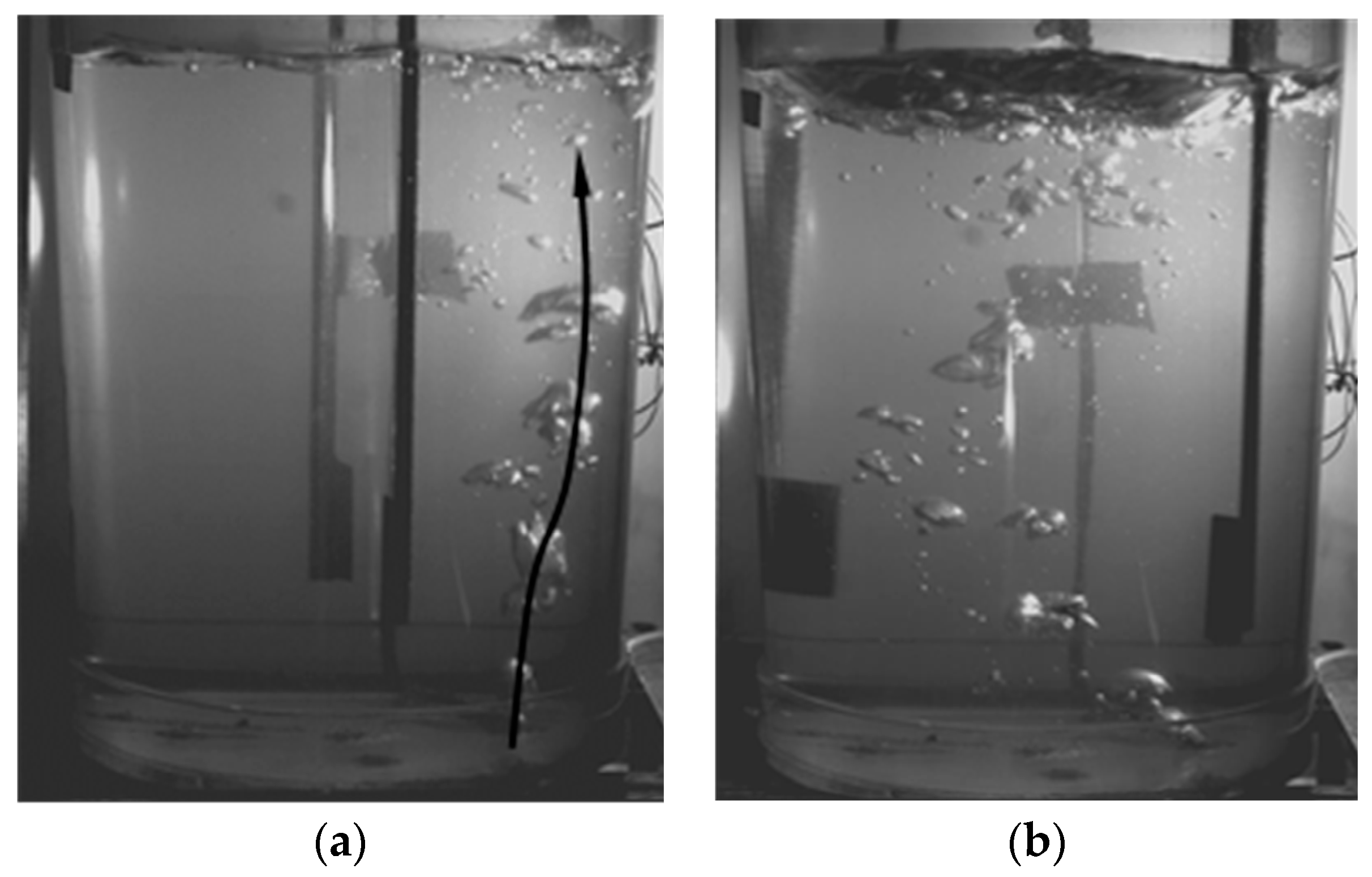



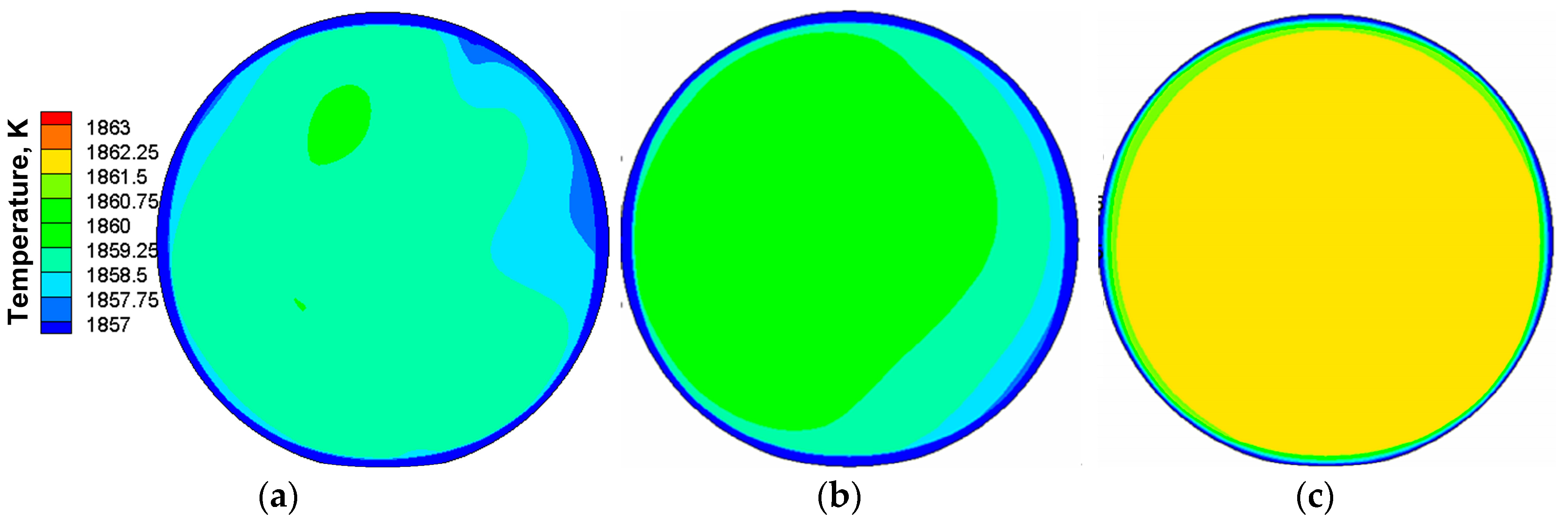
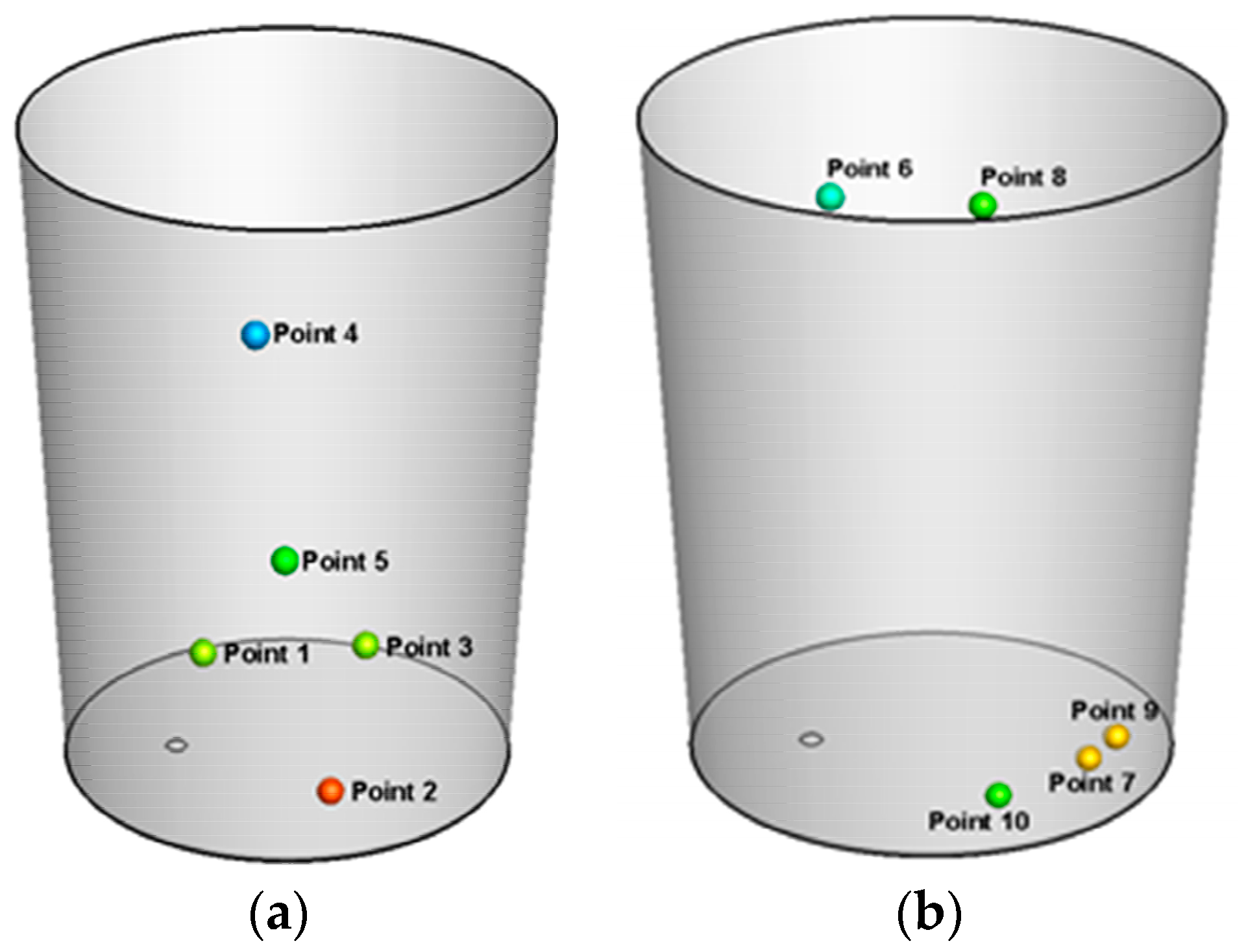

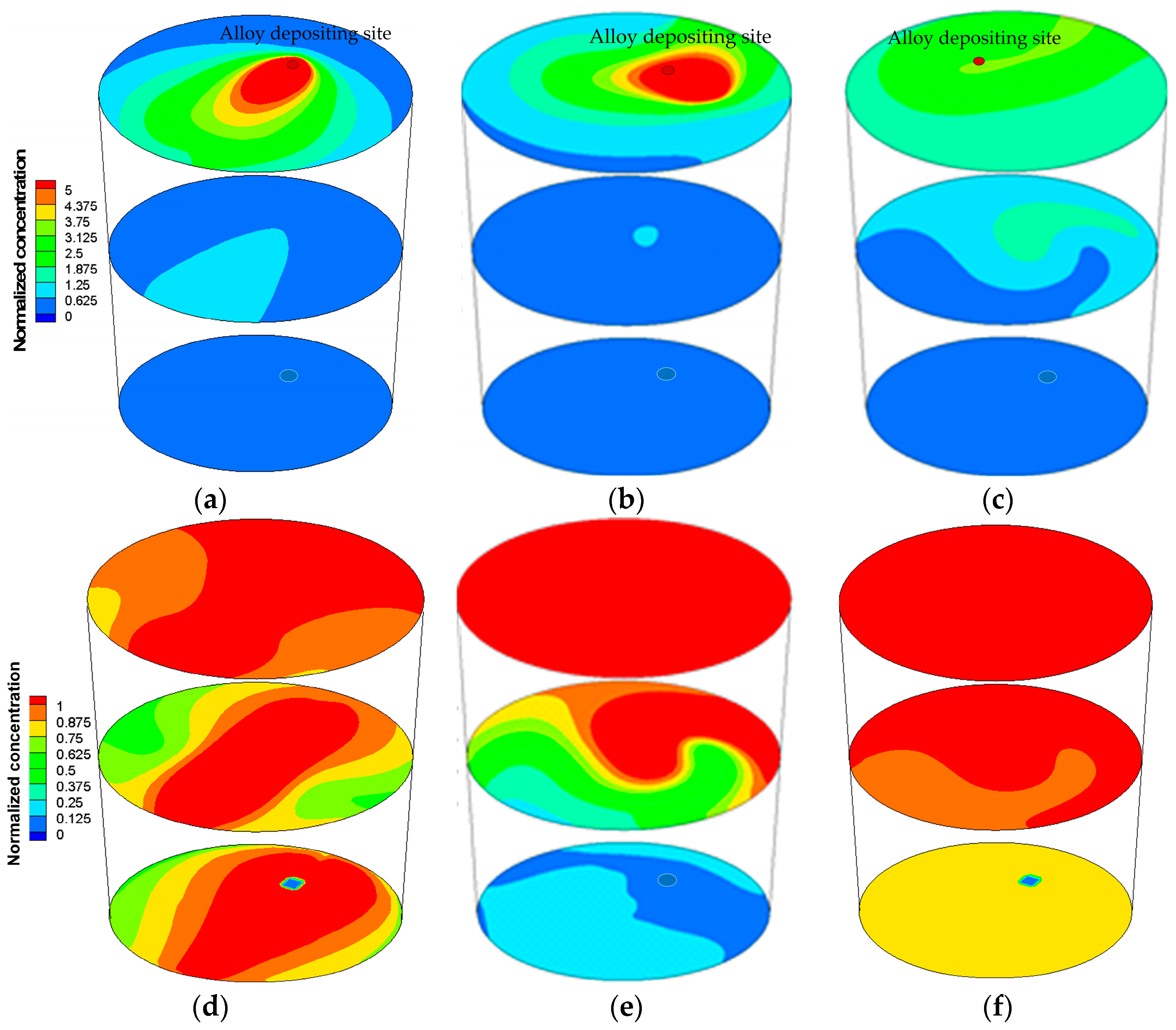
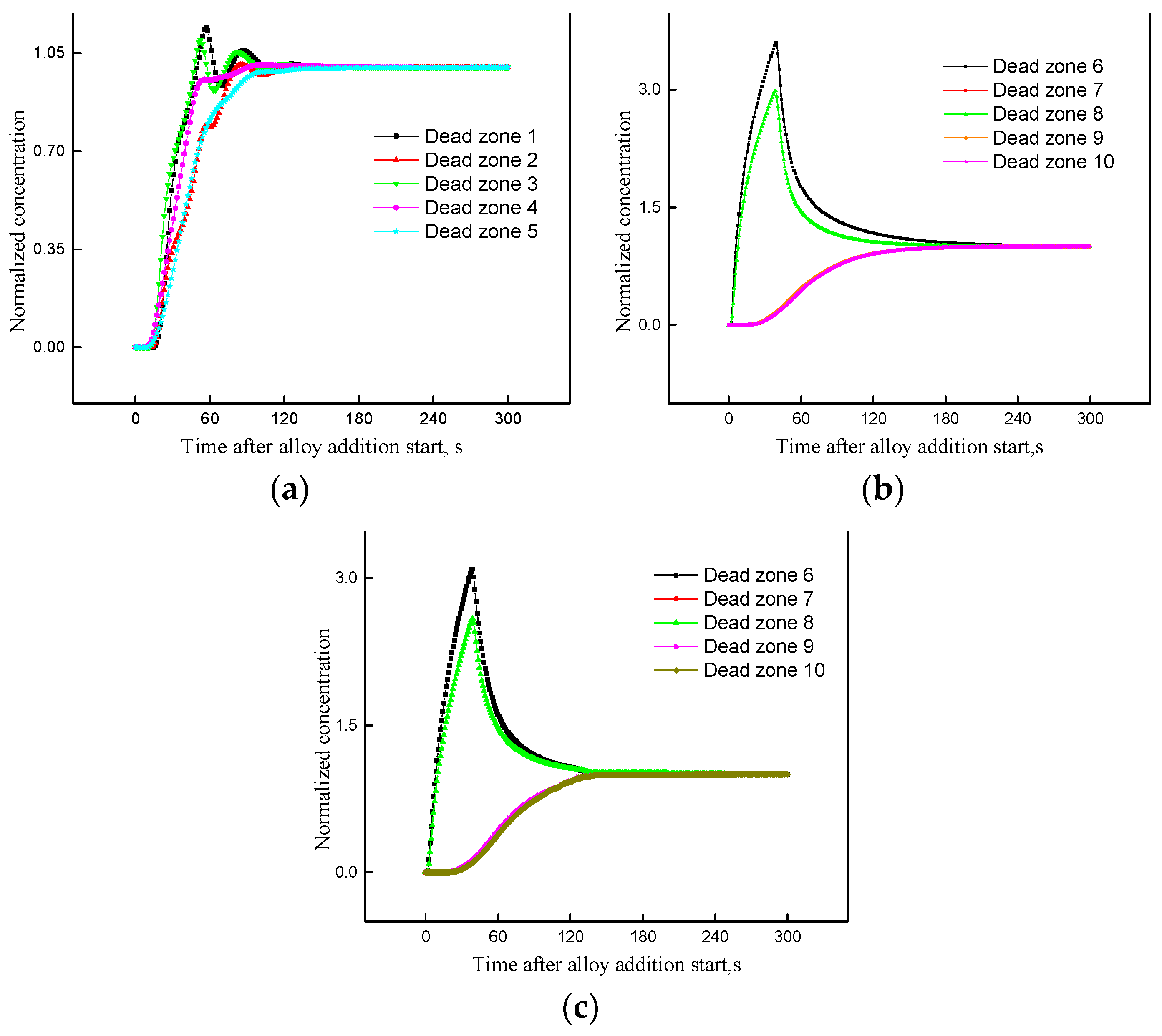
| Parameter | Value |
|---|---|
| Bottom diameter of ladle, m | 2.60 |
| Top diameter of ladle, m | 2.98 |
| Diameter of porous plug, m | 0.118 |
| Height of ladle, m | 3.732 |
| Height of stirrer, m | 0.3 |
| Turns of stirrer | 80 |
| Density of molten steel (ρl), kg·m−3 | 7020 |
| Viscosity of molten steel (μl), kg·m−1·s | 0.006 |
| Density of argon (ρg), kg·m−3 | 1.6228 |
| Viscosity of argon (μg), kg·m−1·s | 2.125 × 10−5 |
| Diameter of argon bubble (db), m | 0.004 |
| Specific heat capacity of molten steel (cp), J·kg−1·K | 434 |
| Thermal conductivity of molten steel (λ), W·m−1·K | 60.5 |
| Electric conductivity of molten steel (σ), S·m−1 | 7.14 × 105 |
| Magnetic permeability (η), H·m−1 | 1.257 × 10−6 |
| Current intensity of EMS, A | 300, 600, 1200 |
| Operating frequency of EMS, Hz | 50 |
| Heat flux density of ladle wall, W/m2 | 11,702 |
| Heat flux density of ladle bottom, W/m2 | 8532 |
| Argon gas rate, L/min | 600 |
| Case | A | B | C | D |
|---|---|---|---|---|
| Total cell number | 138,132 | 208,919 | 323,792 | 453,946 |
| Total node number | 145,310 | 217,920 | 355,880 | 469,800 |
| εux = ∑|uxi − uxD|/∑|uxD| | 0.0388 | 0.0110 | 0.0184 | - |
| εuy = ∑|uyi − uyD|/∑|uyD| | 0.0456 | 0.0367 | 0.0332 | - |
| εuz = ∑|uzi − uzD|/∑|uzD| | 0.0207 | 0.0189 | 0.0143 | - |
| εu = ∑|uiuD|/∑|uD| | 0.0614 | 0.0483 | 0.0290 | - |
| Point | Coordinate (x, y, z) |
|---|---|
| 1 | (−0.4, 0.8, 0.5) |
| 2 | (0.3, −1, 0.6) |
| 3 | (0.3, 0.6, 0.7) |
| 4 | (−0.2, 0.6, 2) |
| 5 | (0, −0.8, 0.9) |
| 6 | (−0.52, −0.4, 3.3) |
| 7 | (0.8, −0.7, 0.6) |
| 8 | (0.08, −0.1, 3) |
| 9 | (1, −0.5, 0.6) |
| 10 | (0.4, −1, 0.55) |
© 2018 by the authors. Licensee MDPI, Basel, Switzerland. This article is an open access article distributed under the terms and conditions of the Creative Commons Attribution (CC BY) license (http://creativecommons.org/licenses/by/4.0/).
Share and Cite
Li, Y.; Deng, A.; Li, H.; Yang, B.; Wang, E. Numerical Study on Flow, Temperature, and Concentration Distribution Features of Combined Gas and Bottom-Electromagnetic Stirring in a Ladle. Metals 2018, 8, 76. https://doi.org/10.3390/met8010076
Li Y, Deng A, Li H, Yang B, Wang E. Numerical Study on Flow, Temperature, and Concentration Distribution Features of Combined Gas and Bottom-Electromagnetic Stirring in a Ladle. Metals. 2018; 8(1):76. https://doi.org/10.3390/met8010076
Chicago/Turabian StyleLi, Yang, Anyuan Deng, Huan Li, Bin Yang, and Engang Wang. 2018. "Numerical Study on Flow, Temperature, and Concentration Distribution Features of Combined Gas and Bottom-Electromagnetic Stirring in a Ladle" Metals 8, no. 1: 76. https://doi.org/10.3390/met8010076





